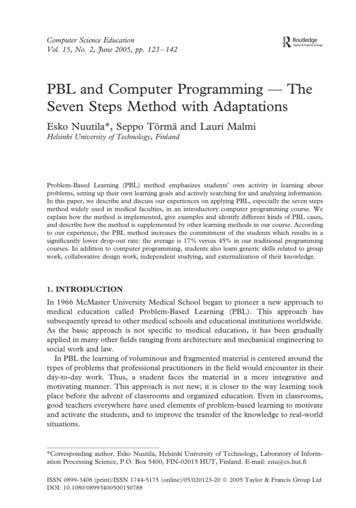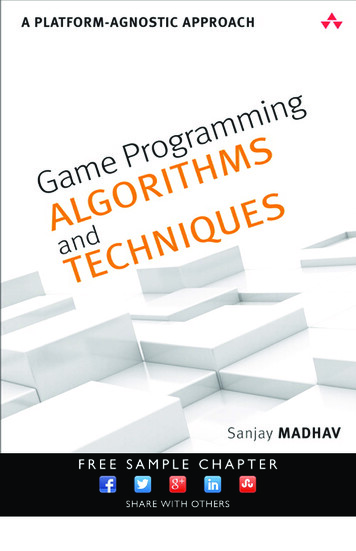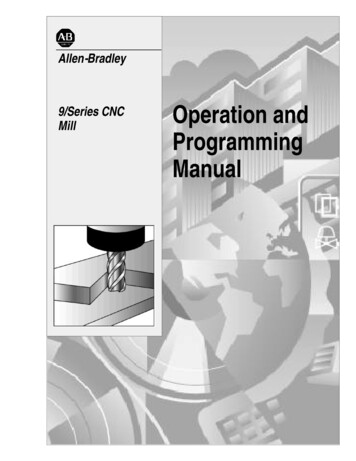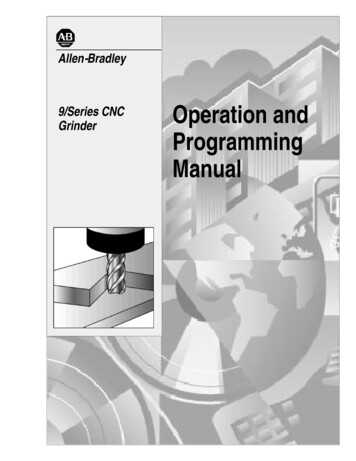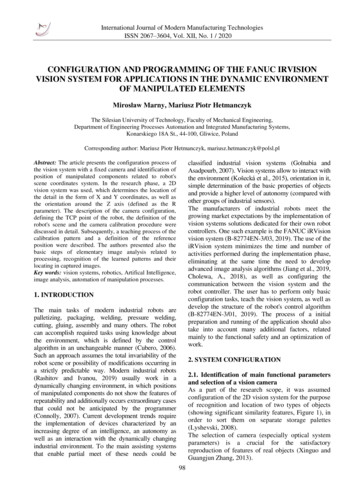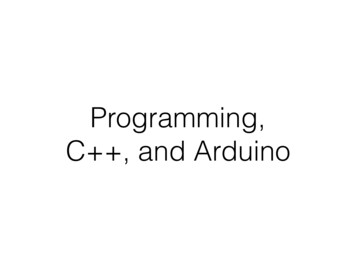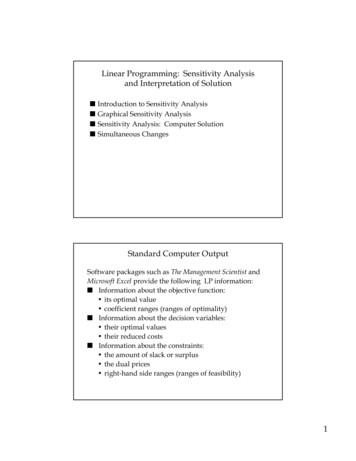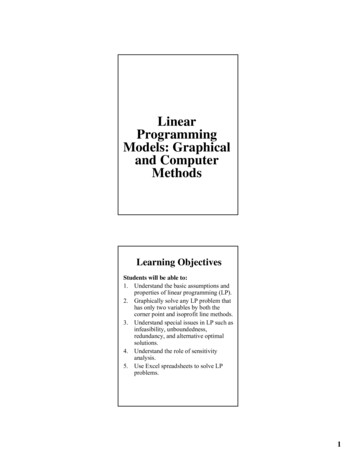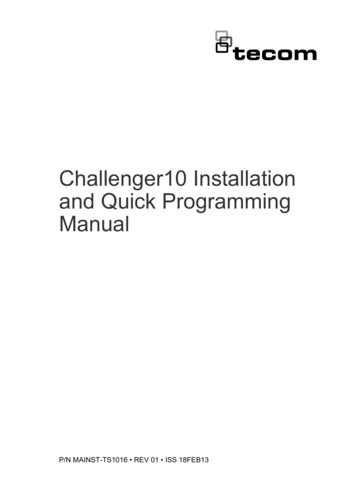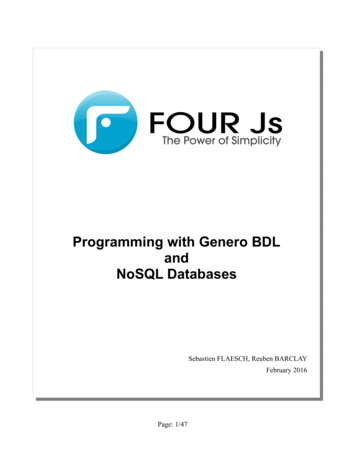
Transcription
Programming with Genero BDLandNoSQL DatabasesSebastien FLAESCH, Reuben BARCLAYFebruary 2016Page: 1/47
Table of Contents1.Purpose of this white paper.32.Executive Summary.33.What is a NoSQL database?.34.Why use a NoSQL database?.45.NoSQL Databases used in this lab.55.1.MongoDB.55.2.IBM Informix-MongoDB.55.3.CouchDB.66.Operating system and software versions for the Lab.7Steps of a Genero program?.77.Access Informix-MongoDB data from Genero through SQL.87.1.Installing MongoDB (shell).87.2.Configuring Informix for MongoDB.87.3.Create an Informix database for this Lab.87.4.Introduction to MongoDB CRUD.97.5.Preparing a sample collection for the demo.107.6.Creating an SQL View.117.7.Accessing raw BSON data from Genero.127.8.Dealing with MongoDB extended JSON.137.9.Missing Informix-MongoDB features.148.Access (native) MongoDB NoSQL data from Genero.158.1.MongoDB basics.158.2.Install and setup MongoDB.158.3.Preparing a sample collection for the demo.178.4.Install and setup RESTHeart.178.5.Query RESTHeart/MongoDB from Genero.209.Access CouchDB NoSQL data from Genero.229.1.Apache CouchDB basics.229.2.Install and setup CouchDB.229.3.Prepare the CouchDB database for Genero.239.4.CouchDB views.289.5.Access CouchDB data from Genero.3010.Open questions.3311.Appendix A: Genero sample for Informix/MongoDB.3412.Appendix B: Genero sample for native MongoDB.3613.Appendix C: Genero sample for CouchDB.42Page: 2/47
1. Purpose of this white paperIntroduction to NoSQL databases (MongoDB, Informix-MongoDB, CouchDB), and show how toaccess a NoSQL DB from a Genero program.Warning: In this white paper, we focus only on databases with JSON data models and APIs.NoSQL databases with other data models and APIs are not covered. Two other important aspectsof NoSQL databases are scalability and security, which are not covered here.2. Executive SummaryNoSQL (originally no sql or no relational) Databases are a form of databases that have grown inpopularity in recent years. As the name suggests, they are databases modeled different from therelational databases typically used in Genero applications. Compared to a relational database, aNoSQL database is seen to have advantages in their simplicity of design, speed, ability to scale, andflexibility of data structures, but at the cost of lack of consistency and ACID transactions.There are a number of different NoSQL database vendors out there and unlike relational databases, alack of standards. This paper shows how Genero programs can read/write from/to 2 different NoSQLdatabases, MongoDB and CouchDB, using their proprietary REST APIs. In addition this paper showshow via Informix databases partnership with MongoDB, Informix SQL statements can be used toread/write to MongoDB. The paper focuses on a sub-class of NoSQL databases known as “Documentstores”, there are other sub-classes with names like key-value, graph that are not covered.If you were using another NoSQL database that is not listed here, we would expect to find that theycould read/write from/to them using similar REST APIs, or perhaps via JAVA or C libraries that can beimported and used by a Genero application. As long as there is an API using one of these techniques,there should be nothing stopping a Genero program from interacting with that particular NoSQLdatabase. There are some areas where our Genero syntax could be extended to simplify coding that arelisted in this document.So there are no roadblocks stopping Genero developers working with NoSQL databases via thetechniques shown in the examples in this document. The techniques used in this white paper can beused as stepping stones to a solution for other NoSQL databases.3. What is a NoSQL database?A NoSQL database can handle a large amount on data using a flexible schema, and servicing a lot ofclients.NoSQL database: Data flexibility Service scalabilityThe NoSQL ecosystem includes several brands of database systems, using different data models (keyvalue, (JSON) document, column-based, graph). The original need came from companies likeFacebook, Google and Amazon, for 21st Century Web demands to address the “Big Data” challenge.NoSQL databases can be categorized into aggregate-oriented NoSQL databases (document-based,column-based, key-value-based) versus graph-oriented NoSQL databases (graph-based). AggregatePage: 3/47
oriented QL databases are designed to make complex queries on schema-less data (ex: map-reducetechnology), while graph-oriented NoSQL databases is good at making complex queries on elementsinterconnected with an undetermined number of relations between them.Some well known NoSQL databases: Cassandra, MongoDB, CouchDB, Redis, ElasticSearch, Riak,Hbase, Couchbase, OrientDB, Aerospike, Neo4j, Hypertable, Accumulo, VoltDB, Scalaris,RethinkDB .Resources: Intro to NoSQL by Martin Fowler: https://www.youtube.com/watch?v qI g07C Q5I Brief overview of NoSQL solutions: vsredis A visual guide to NoSQL Systems: ems IBM blog about NoSQL with P-Overall 20131018.pdf?lang en4. Why use a NoSQL database?The two main reasons you would use a NoSQL database over a more traditional relational SQLdatabase are flexibility of schema and data structure, and speed with large data sets.An SQL table structure enforces the same columns on every row of a database table. A NoSQLdatabase does not enforce this, thus giving you greater flexibility. This greater flexibility not onlyaccounts for changes in schemas over time but differences between rows. Different data structuressuch as key-value stores, document databases, graphs also give more flexibility about how data isarranged and accessed.Relational databases typically scale vertically, that is, as the size of the database increases, so too mustthe system resources on the server. Adding servers does not increase performance proportionately. As aresult, this equates to larger, more expensive hardware. A NoSQL database typically scales horizontally,that is as your data volumes increase, you can typically partition a database across several commodityservers.Page: 4/47
5. NoSQL Databases used in this lab5.1. MongoDBMongoDB is a NoSQL database based on JSON Document data model.MongoDB: NoSQL DB based on JSON documentsMongoDB handles BSON/JSON documents ( SQL records) in collections ( SQL tables).Documents are identified by a (universal / world-wide) unique ObjectID ( SQL primary key). Formore details about MongoDB and the JSON data model, see https://docs.mongodb.org/manual/datamodeling/.5.2. IBM Informix-MongoDBIBM Informix IDS 12.10 introduced NoSQL support with the new JSON/BSON SQL data types andthe MongoDB listener.The Informix MongoDB listener acts as a native MongoDB server, using the IDS server for datastorage with the BSON data type. The BSON data type is a binary/compacted version of the JSON datatype.Informix NoSQL jsonListener: Replace a MongoDB serverMongoDB client applications can directly access the Informix MongoDB server as if it was a nativeMongoDB server.Page: 5/47
5.3. CouchDBCouchDB is a NoSQL database based on JSON Document data model. The API to access data isHTTP/REST. Complex Map/Reduce queries are done in JavaScript. An interesting feature of CouchDBis Multi-Version Concurrency Control.CouchDB: NoSQL DB based on JSON documentsResource: http://couchdb.apache.org/Page: 6/47
6. Operating system and software versions for the LabThe OS used for this lab is a Linux Debian (Jessie). Command-line examples are Linux/UNIX specific.However, you can easily adapt the examples to use them on a computer running Microsoft Windows. Genero BDL 3.00.05 MongoDB 3.2.1 RESTHeart 1.1.3 Informix IDS 12.10.FC6 CouchDB 1.6.1Steps of a Genero program?Below are the basic steps a Genero program would typically do with a NoSQL database:1. Fetch JSON data from the NoSQL DB2. Convert JSON to a RECORD as a document (or DYNAMIC ARRAY OF RECORD, as acollection)3. View the data (DISPLAY MENU or DISPLAY ARRAY), let the user modify the data (INPUT)4. Convert RECORD back to JSON5. Update data in the NoSQL DB with JSONPage: 7/47
7. Access Informix-MongoDB data from Genero through SQL7.1. Installing MongoDB (shell)You need to install at least the MongoDB shell, to execute MongoDB commands (i.e. MongoDBCRUD operations) against the Informix server.To check that the MongoDB shell / client is installed, try the following command: mongo --helpMongoDB shell version: 3.2.1usage .For more details about MongoDB installation, see https://docs.mongodb.org/manual/installation/7.2. Configuring Informix for MongoDBYou need to setup your Informix IDS 12.10 server, to enable the MongoDB listener (jsonListener). Ifyou have installed IDS 12.10 with default options, the jsonListener will be configured by default andstarted.To check if the Informix jsonListener is started, log in as informix user and verify that thejsonListener.jar Java program is started: ps -aef grep jsonListener.jarYou might also want to check the jsonListener log file: tail INFORMIXDIR/jsonListener.logYou can also check the jsonListener configuration in the etc/jsonListener.properties file: tail INFORMIXDIR/etc/jsonListener.propertiesIf the jsonListener is not started, it needs to be configured; See Informix documentation for moredetails.7.3. Create an Informix database for this LabA demo/test database needs to be created for this Lab in the Informix server.Warning: Use and create the database with UTF-8 locale (CLIENT LOCALE / DB LOCALE). echo CLIENT LOCALEen us.utf8 dbaccess - create database jsontest with buffered log;Database created.By default the Informix jsonListener is configured to execute SQL database operations as the ifxjsonuser. Thus, you need to grant permissions for the ifxjson user on the new created database: grant connect to ifxjson;Page: 8/47
Permission granted. grant resource to ifxjson;Permission granted.Test access to the new created database with the MongoDB shell: mongo 127.0.0.1:33345/jsontestMongoDB shell version: 3.2.1connecting to: 127.0.0.1:21408/jsontest show collections; 7.4. Introduction to MongoDB CRUDIn this section, we will use the MongoDB shell to create a collection and a set of documents.Note: This is just an introduction to the MongoDB query language, you
Some well known NoSQL databases: Cassandra, MongoDB, CouchDB, Redis, ElasticSearch, Riak, Hbase, Couchbase, OrientDB, Aerospike, Neo4j, Hypertable, Accumulo, VoltDB, Scalaris, RethinkDB . Resources: Intro to NoSQL by Martin Fowler: https://www.youtube.com/watch?v qI_g07C_Q5I

![Fluent Python : [clear, concise, and effective programming]](/img/1/799981060.jpg)
